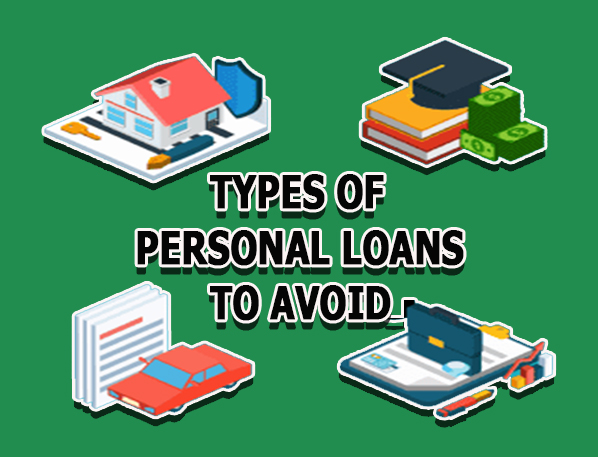There are plenty of reasons to take out a loan, and when expenses start to mount, it might be your only choice. However, some loan kinds have such exorbitant costs or interest rates that they can trap borrowers in a never-ending cycle of debt, where they have to keep taking out new loans to pay off old ones. The question, “What are the types of personal loans you should avoid?” has been posed to us.

Personal lines of credit, debt consolidation loans, and secured and unsecured loans are just a few of the various types of personal loans available. There are a ton of loan options available if you need money quickly. However, when you need a loan, the types of personal loans to avoid are those that have high interest rates, extremely short repayment terms, or clauses that jeopardize valuable assets.
What Are the Types of Personal Loans to Avoid
Personal loans should only be utilized as a last alternative due to their excessive interest rates. Borrowers without access to a bank account or with poor credit may have few choices. If possible, avoid taking out these types of personal loans. Furthermore, if you are incapable of reimbursing the loan fast, ensure that you make your expenses on time.
This article has listed eight various types of personal loans that you should avoid because of their high interest rates, extremely short repayment terms, or clauses that jeopardize valuable assets. The following include;
Cash advance app
Cash advance apps permit you to borrow little amounts from your subsequent earnings (maximums range from $200 to $500). Some apps charge a monthly subscription fee, while most charge a fast-funding fee with the option to tip. These expenses are small, but they add up. Most apps determine the amount you can borrow depending on your bank account and transaction history, rather than your credit score. Within two weeks, or on your next payday, the apps withdraw funds from your bank account for repayment.
Credit card advance
To obtain a short-term cash loan from a bank or ATM, you can use your credit card. It’s a costly but useful method of getting money. Loan interest rates are usually higher than purchase interest rates, on top of the cash advance fees, which are usually a set amount (between $5 and $10) or up to 5% of the loan amount.
Pawnshop loan
This loan is secured. You take out a loan against an asset that you leave at the pawnshop, such as jewelry or electronics. If you do not repay the loan, the pawnshop may sell your asset. Pawnshop loans can carry interest rates as high as 200% APR. However, they’re probably less expensive than payday loan rates, and if you default on the loan, you just lose your belongings rather than having your credit ruined or facing collection action from debt collectors.
Title loans
One kind of secured loan that uses your car as collateral is a title loan. You might forfeit your car if you are unable to make loan payments. With a title loan, you can usually borrow between $100 and $10,000, though $1,000 is the typical amount. Title loans typically have a duration of one to six months. Triple-digit interest rates are charged by lenders, making borrowing money costly.
Payday loans
Payday loans are quick and easy but often have high fees and short repayment terms. The annual percentage rate (APR) for a $300 loan with a $45 fee and 14-day repayment period is nearly 400%. If full repayment isn’t possible, additional fees may be charged. Consider alternative options like large banks and credit unions for better terms.
High-cost installment loans
Installment loans, including personal, mortgage, auto, and student loans, are a type of loan where the money is received upfront and repaid in installments. These loans can range from $500 to several thousand dollars, with repayment terms ranging from a few months to two years. However, high fees or interest rates can result in APRs over 150%. Many borrowers end up refinancing their loans, potentially paying more in fees and interest than the original loan.
Family loans
If you have friends or family who can lend money for an unexpected expense, it’s a good option to establish clear loan terms. If the loan amount exceeds $10,000, the IRS requires a written agreement detailing loan terms, repayment schedule, and interest charges. The person lending must also report interest income on taxes. However, these loans can strain relationships if repayment is delayed, as nearly half of all family loans never get repaid.
401(k) Loans
401(k) loans may seem like a simple solution, but they can negatively impact your retirement savings. These loans carry low interest rates and are tax-free, but they are repaid with after-tax dollars, causing you to miss out on earnings. If you lose your job, you must repay the loan within sixty days.
If you cannot repay the loan, it becomes a hardship distribution, requiring taxes and an early withdrawal fee. While experts may argue that 401(k) loans are better than other options, it’s important to consider other options first. If you had contributed the borrowed funds to your retirement account, they could have grown in value.
Final Thoughts
One can choose from a variety of personal loan types which has both advantages and disadvantages. Before applying for a personal loan, understand what to expect and how the process works. Furthermore, make careful comparisons between lenders to avoid some types of personal loans and get the best one.

